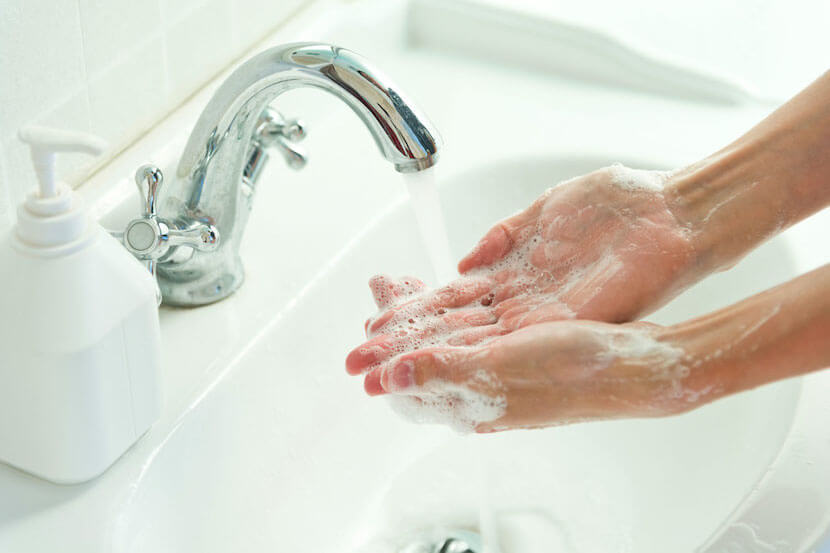If you have ever wondered whether you are washing your hands properly, then wonder no more. A recent Rutger University study provides us with the information we need to wash our hands thoroughly and remove germs that make us ill and spread disease.
The study was led by Dr. Donald Schaffner, Distinguished Professor at Rutgers University and extension specialist in food science at the university’s School of Environmental and Biological Sciences, whose research interests include handwashing and cross contamination.
Handwashing is key to good health. We learned that from a very young age. Many of us can recall our mothers telling us to sing “Happy Birthday” twice while washing our hands. (Singing it twice adds up to 20 seconds.) Once we learned to count, we were told to count up to 20 as we washed our hands.
Proper handwashing is so important that the U.S. Centers for Disease Control and Prevention even produced videos designed to teach people how to wash their hands.
https://www.youtube.com/watch?v=lhmYLwDdPuE
The need to wash hands properly is particularly important in food service industry where improper handwashing could lead to food contamination and jeopardize the health of many. To minimize risk, the U.S. Food and Drug Administration (FDA) has even issued a guideline to food service industry on how hot the water should be.
According to Section 5-202.12(A) of the 2013 Food Code, handwashing sinks “shall be equipped to provide water at a temperature of at least 38ºC (100ºF) through a mixing valve or combination faucet.”
The guideline has been interpreted by many states, according to Schaffner, to require handwashing at 100ºF.
The problem is, up until Schaffner’s study, the policy for washing hands at high temperature has not been supported by scientific evidence.
Also, as we know, heating water consumes energy, and it takes more energy to heat water to a higher temperature.
Hot water is not necessary
In reality, water doesn’t have to be hot to remove germs from our hands, according to Schaffner’s study.
“People need to feel comfortable when they are washing their hands but as far as effectiveness, this study shows us that the temperature of the water used didn’t matter,” Schaffner said in a statement.
The study, which was published in the Journal of Food Protection, involved 21 participants over a six-month period.
The participants had high levels of a harmless bacteria placed on their hands numerous times over a period of six months, and then had to wash their hands in 60-degree, 79-degree, or 100-degree water temperatures. They used 0.5 ml, 1 ml, or 2 ml volumes of soap to wash their hands.
The study’s conclusion that hot water is not necessary for handwashing is good news for the environment.
“This study may have significant implications towards water energy, since using cold water saves more energy than warm or hot water,” Schaffner told TUN.
Schaffner hopes that the FDA, which is scheduled to review the existing code in 2018, will take the study into account and revise its water temperature policy at that time.
“I think this study indicates that there should be a policy change,” Schaffner said.
“Instead of having a temperature requirement, the policy should only say that comfortable or warm water needs to be delivered. We are wasting energy to heat water to a level that is not necessary.”
Lathering beyond 20 seconds is not essential
Another key finding of the study is that it is not effective to wash our hands for more than 30 seconds.
That sounds counterintuitive. One would think the longer one takes, the more effective it would be. So, why is it not?
Because the study found most harmful bacteria is removed from our hands within 30 seconds. If we wash our hands for longer than 30 seconds, we will still not dislodge bacteria embedded in deeper layers or pores, or ones that “are biochemically attached to skin.”
The study also found that microbial reduction will not increase significantly beyond 10 to 20 seconds of lather times. It is enough then if we lather our hands for 10 to 20 seconds.
“Based on our research, I recommend at least a 10-second ‘lather’ time,” Schaffner told TUN.
“This does not include the time to wet the hands and apply soap and to rinse soap off.”
Type of soap, but not amount, is significant
As mentioned above, participants in the study used 0.5 ml, 1 ml, or 2 ml volumes of soap. The amount of soap used did not make a difference in microbial reduction.
“We … found no difference between 0.5, 1, and 2 mL,” said Schaffner.
If that’s the case, there is no need to use more than 0.5 mL of soap.
The study, however, found that the type of soap used made a difference.
“We saw a small but highly statistically significant difference between bacterial and non-antibacterial soap,” said Schaffner.
It is more effective to use antibacterial soap to wash hands.
“This is consistent with other research we’ve done with antibacterial soap,” said Schaffner.
“Our computer simulation predicted that using antibacterial soap would result in >50% fewer illnesses when food workers’ hands were contaminated by pathogenic bacteria.”
Conclusion
The Rutgers study has given us the information we need to wash our hands properly, so we can stay healthy and prevent diseases from spreading. We need only lather for 10 to 20 seconds. We should use water that’s comfortable (but not hot) and about 0.5 mL of antibacterial soap. We can save energy by not using hot water and save money by not wasting soap.



